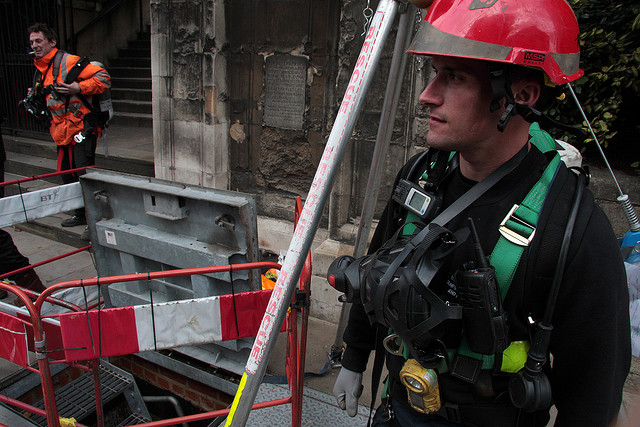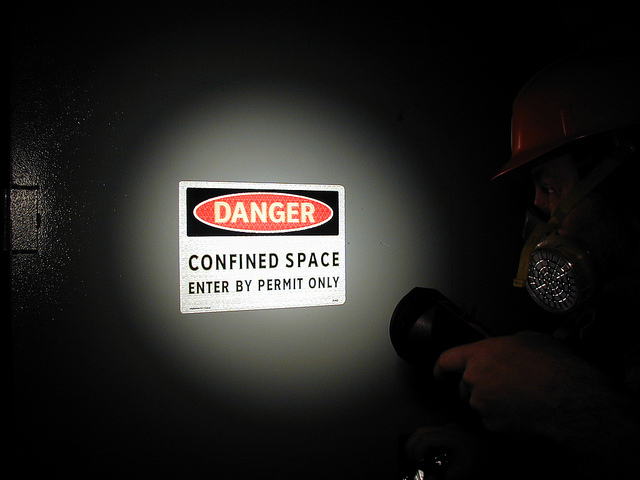Hazard Assessment in Confined Spaces
In the previous article ‘Working in Confined Spaces Risk Assessment’, we looked at the definition of ‘confined space’ and what generic risks and hazards are associated with it. It is clear that confined spaces fall under the mandate of what constitutes high risk construction work. Based on the Work Health and Safety Regulation 2011, Safe Work Australia outlines many of the considerable hazards involving with working in confined spaces but there substantial details to each of these that should be noted.

o Presence of harmful airborne contaminants
o Unsafe oxygen level caused when oxygen in the atmosphere is:
- displaced by gases produced during biological processes, for example, methane in a sewer
- displaced during purging of a confined space with an inert gas to remove flammable or toxic fumes
- depleted inside metal tanks and vessels through surface oxidation (for example, when rust forms)
- consumed during combustion of flammable substances
- absorbed or reacts with grains, wood chips, soil or chemicals in sealed silos.
- reacts with chemicals that increase risk of explosion or fire (eg hydrogen peroxide)
- leaks from oxygen tank or fitting during use of oxy-acetylene equipment
o Fire and explosion
- Flammable gas, mist or vapour in atmosphere exceeds 5% of its lower explosive limit (LEL)
- Evaporation of flammable residue
- Use of flammable materials
- Chemical reaction (eg build up methane from sewer)
- Presence of combustible dust (flour in silo)
o Introduction of an ignition source into atmosphere. Such sources may include:
- open flames and hot surfaces
- electrical equipment
- internal combustion engines
- metal tools striking metal surfaces
- spark-producing equipment for example grinding wheels
- static electricity
o Engulfment leading to asphyxiation
- Confined spaces with stored materials including plastics, sand, liquids, fertiliser, grain, coal, coal products, fly ash, animal feed and sewage
o Uncontrolled introduction of substances
- Substances include steam, water or other liquids, gases or solids that may result in a person drowning, being overcome by fumes or other harm
- Build up of exhaust fumes, including carbon monoxide, from nearby vehicles including LPG forklifts
o Contact with biological agents
- Such as micro-organism like virus, bacteria or fungi which can cause infectious diseases, dermatitis or lung conditions such as hypersensitivity pneumonitis
- Sewers, grain silos and manure pits are confined spaces where biological hazards may be present

o Exposure to mechanical hazards
- The entanglement, crushing, cutting, piercing or shearing of parts of a person’s body from mechanical hazards including augers, agitators, blenders, mixers and stirrers
o Contact with electrical hazards
- Electrocution, shocks or burns caused by cables, transformers, capacitors, relays, exposed terminals and wet surfaces where electrical circuit and electrically powered plant are used
o Skin contact with hazardous substances
- Increased likelihood of skin contact with contaminated surfaces resulting in burns, irritation, allergic dermatitis or long-term systematic effects
o Noise
- Noise caused by plant, work method or process may be amplified due to noise reflections off hard surfaces
o Manual tasks
- Physical restraints of confined space may exacerbate hazards relating to manual tasks
- Further hazards may arise from use of PPE that restricts movement, grip and mobility
o Radiation
- Sources of radiation may include x-rays, lasers, welding flash, radio frequency and microwaves
o Environmental hazards
- Factors that contribute or cause harm such as heat or cold stress, inadequate lighting
- Slips, trips and falls
o Control methods for hazards near or adjacent to a confined space (pg 19)
- Hazards outside the confined space: ie vertical opening = risk of falling in space
- Traffic hazards should the confined space be located under or near a road
- Exhaust gas from a adjacent vehicle or machine may contaminate the confined area
- Confined areas adjacent to work involving flammable substances

